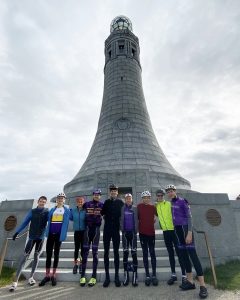
Dear Cyclists,
Well done! We’ve made it through 2012 and are on sure footing for the start of 2013. As we inch closer to the start of the ECCC racing season in March, it’s time to start turning up the intensity.
The goal of the training season up to this point was:
– develop comfort riding on the bike
– work on pedaling form with drills
– build the aerobic base
– begin to introduce tempo workouts to work our way up to LT workouts
If you’ve worked on the following, you’re in fantastic position. If you haven’t been as vigilant as you would have liked, never fear. It may mean that the next weeks will feel like a big jump, but just pace yourself appropriately so that you don’t get burned out or overtrained.
Here’s what we’re doing now:
1) TESTING
Depending on your disposition, this will either be really fun or really fucking horrible. Testing is how we set a baseline as to your current level of fitness. It allows us to look back and see how you have progressed over the season. The goal is really just to get good data. If you have a heart rate monitor, it’s crucial that you wear that during testing. If you have a power meter, even better. If you just have your bike, it’ll do.
It would be nice to do this testing outside, as an all-out effort up Petersburg Pass. Friday, Saturday, and Sunday actually look rideable, if you have warm clothes (highs in the mid 30s and sunny). If you can ride outside, this is your best option. Otherwise, if you want to ride inside, then the trainer will work too.
In either case, here’s how to do the test:
– make sure you are well-rested. No hard rides for two days before hand.
– warm-up thoroughly. No less than 30 minutes. Include some medium-hard efforts for 1-2 minutes.
– begin the test. This is a 20 minutes all-out test. Ideally, you want your output to be steady over this time period. If you are totally fried after 8 minutes, that’s no good. If you are just a little winded once it’s over, that’s also no good. Rule of thumb is that you should spend AT LEAST the last 5 minutes in absolute agony seriously questioning why you ever listened to me in the first place. When you are done, you should be 100% completely drained. Nothing left in the tank. You get the idea.
– again, collect as much data as possible. Heart rate, power, speed, etc. Also pay attention to your perceived rate of exertion. Your output on this test will inform how you do future workouts. Record this data to the best of your ability. This way, when we repeat testing you can compare.
– especially if you’re riding inside, you’ll want to do this with other people.
2) TRAINING
Once you’ve done testing, here’s what the schedule should look like. I’ve assigned days of the week, but if you need to move things around, that’s fine.
Monday: drills (single-leg drills and spin-ups). Focus on good form. This should not be overly taxing. Sort of an active recovery day.
Tuesday: SE workout: 3×15 at tempo with low cadence (~70), 5 minutes recovery in between. This means (after warming up) to do 3 sets of 15 minutes at medium-hard pace (think 75-85% of max HR) with a low cadence, and 5 minutes of active rest between each set. You should feel it a little at the end of the workout, but this is definitely not all-out.
Wednesday: 8×6 at high tempo with 4 minutes rest in between. Choose your own cadence today. This means that you’ll be doing 8 sets of 6 minutes at a slightly harder pace than yesterday. Again, this should not be all out, but let’s say that at the end you should feel pleasantly tired. However, if you would not have been able to do two more sets at the same pace, you went too hard.
Thursday: recovery/crosstraining day. Take the day off, spin easy for 30-60 minutes, ski, or do whatever as long as its not too taxing.
Friday: repeat Tuesday
Saturday: longer ride. Maybe ride outside? If it’s nice enough try to get out for a couple hours for a relaxed aerobic ride. Otherwise try to ride on the trainer for 90-120 minutes at a moderate pace.
Sunday: another recovery day.
3) OTHER STUFF
– Crosstraining: take advantage of skiing, running, etc as a chance to mix it up a little, but the best training for cycling is cycling. The more time you spend on the bike the better, but don’t obsess over it.
– Weights: in the previous training update I included a weights regimen. This is a good addition/substitute for the SE workout. Try to find other people to do this with to make sure that your form looks okay.
Questions? I’m more than happy to answer them!


